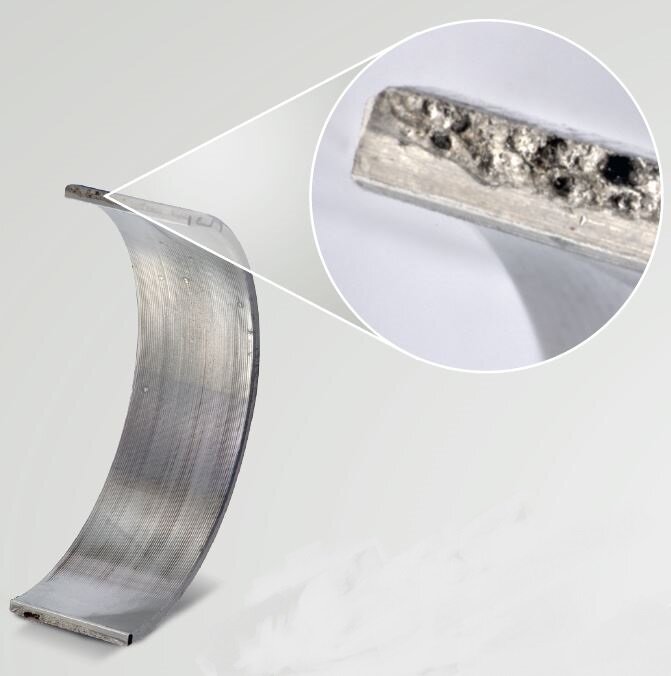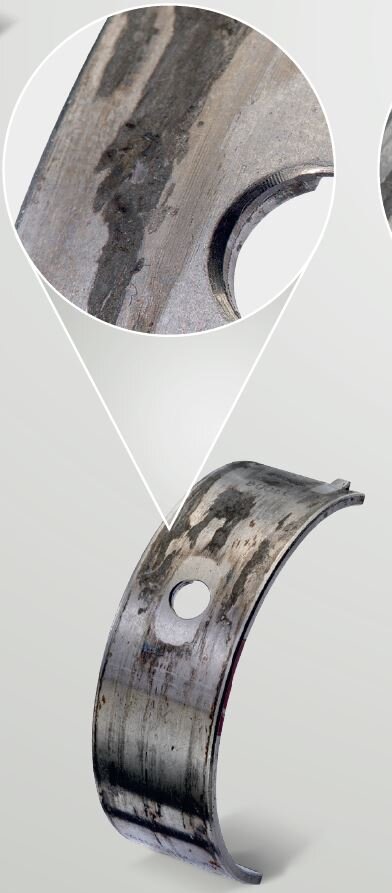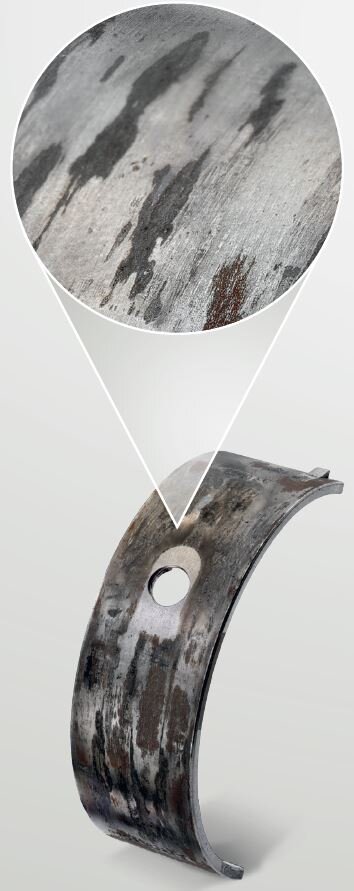Frictional corrosion / Contact corrosion
DESCRIPTION OF THE DAMAGE
- Scarred surface of the back of the bearing or in the area of the parting face
- Roughened, matte areas

In the area of the parting face, signs of movement of the bearing shell in the form of frictional corrosion may also be visible. The material surface has clearly changed.

Upper main bearing shells steel-aluminium composite
Clear traces of frictional corrosion can be recognised – in part with areas of torn-out material.
Clear traces of frictional corrosion can be recognised – in part with areas of torn-out material.

Here, the clear characteristics of surface frictional corrosion are recognisable: with areas of torn-out material and scarring of the surface.
Damage assessment
If the bearing shell is not sitting correctly in the bearing block, frictional corrosion is caused due to the resulting relative movement (micro sliding movements). The frictional heat generated by the movement of the bearing cannot be dissipated by the lubricant as in the inside of the bearing, but instead causes local overheating of the steel back. The overheating causes fusing and the scarred surface typical of this. There is a transfer of material between the back of the bearing and the bore.
The surrounding medium can penetrate into the surface (which is already roughened and chemically activated) and accelerate the corrosion.
Frictional corrosion reduces the integrity of the material, as the formation of micro cracks is facilitated. Fatigue damage with consequences such as cracks or fatigue fractures can be the result.
The surrounding medium can penetrate into the surface (which is already roughened and chemically activated) and accelerate the corrosion.
Frictional corrosion reduces the integrity of the material, as the formation of micro cracks is facilitated. Fatigue damage with consequences such as cracks or fatigue fractures can be the result.
Possible causes
- Insufficient preloading due to bore being too large or bearing shell being too small
- Bearing shell protrusion too small: the protrusion of the bearing shell guarantees the reliable fit through sufficient press fitting
- Housing deformation: for crankcases made from aluminium, the housing and bearing shell can deform differently under the effect of extreme temperatures, whereby the reliable fit of the bearing may no longer be sufficient
- Bending of the crankshaft: the bending of the crankshaft leaves a particular wear pattern on the sliding surface of the bearing
- Insufficiently tightened bolts
- Vibrations from the housing or the crankshaft which cause micro-movements (vibration may also be caused by foreign particles and / or hollow areas)
Remedy
When the signs of contact corrosion are recognisable, the bearing must be replaced as the integrity may already be reduced.
- Locating hole and bearing shell outer diameter must be within the tolerance range so that the specified bearing clearance can be met
- Protrusion: in order to create the desired press fit for the reliable fit, the bearing shell must have a sufficient protrusion
- Check the locating hole and housing for possible deformation
- Balance crankshaft during installation and check strain on the shaft
- Tighten bolts in accordance with the manufacturer‘s specifications with regard to tightening torques and the tightening sequence
- Check engine for vibration during operation